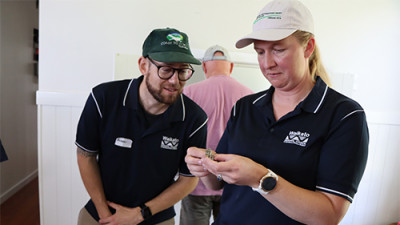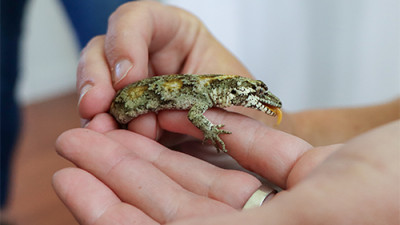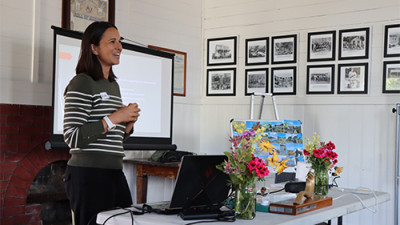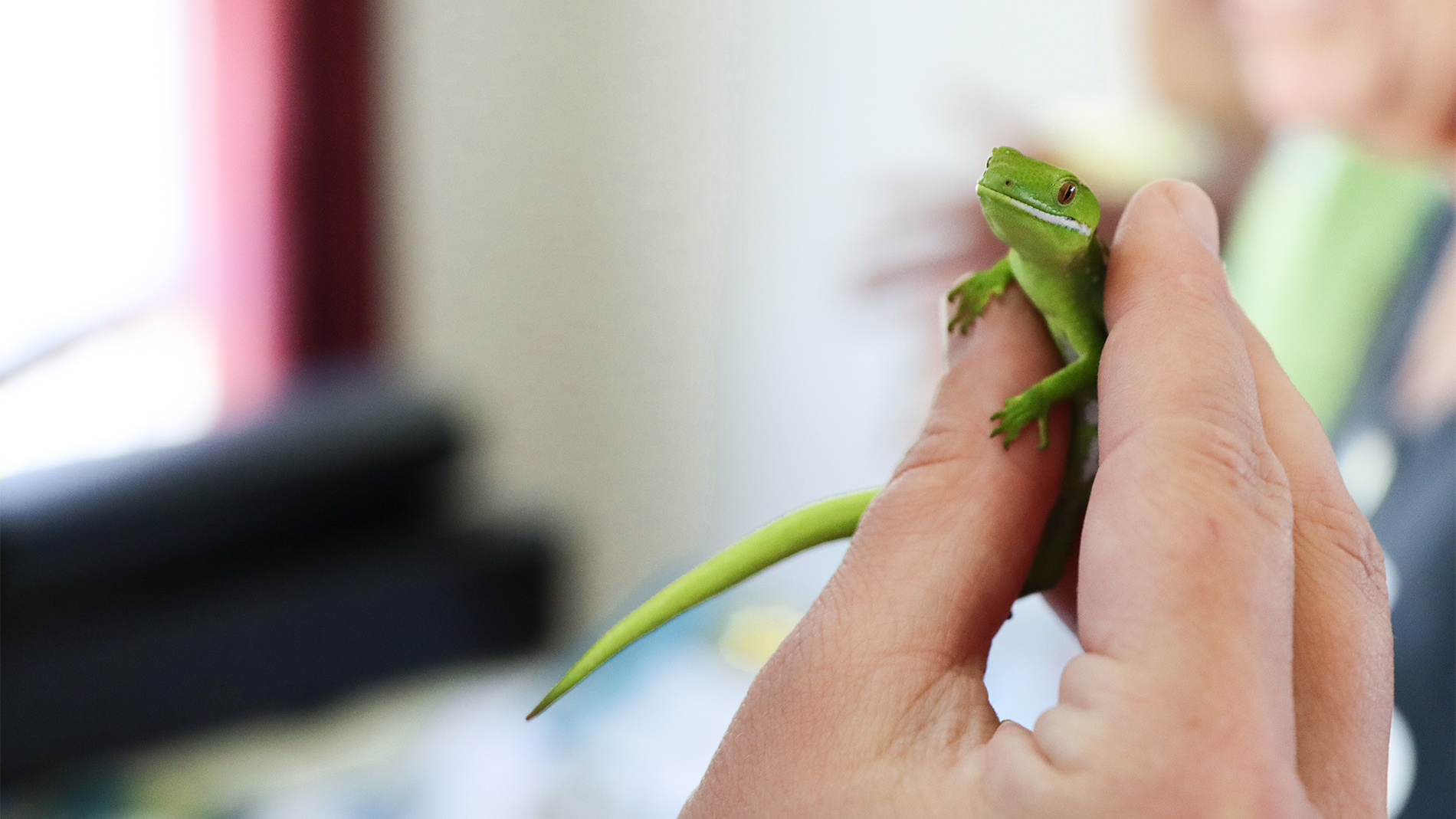"We can achieve weed management goals, restore dunelands and protect lizards at the same time. It just takes the right approach which can sometimes take a little longer to achieve."
- Jacqui Wairepo, ecologist and lizard specialist.

A mid-morning fieldtrip to the picturesque Otama Beach
What happens if you want to remove pest plants, but it turns out that some rather special native lizards have made themselves at home in this otherwise undesirable habitat?
Good question. Not to mention a tricky one.
This was one of the topics up for discussion at the Waikato Coastcare Mini Conference 2024 in Kūaotunu, a small coastal township on the east coast of the Coromandel Peninsula, just north of Whitianga.
Hosted by Kūaotunu Dune Care Group, the wānanga drew together experts and volunteers for a day of shared learning and reflection on the hard mahi that faces those passionate about caring for our coasts.
Coastcare Waikato is a partnership between local communities, iwi, district councils and Waikato Regional Council, working together to protect and restore our precious coasts.
Representatives from Waikato Regional Council, Thames-Coromandel District Council, Ngāti Hei, the Coastal Restoration Trust of New Zealand, Bay of Plenty Regional Council, the Department of Conversation, Kūaotunu Dune Care Group, Otama Reserves Group, curious members of the public and even a professional herpetologist took part.
Themed “Think like a Skink,” the mini conference celebrated the end of the 2024 planting season. Invasive pest plants, predator control, seed collection methods and lizard conservation all featured on the agenda.
“The 2024 Coastcare planting season needed us all to start thinking like a skink after the East Coast Coastcare team started noticing more and more lizards at their sites,” says Waikato Regional Council Biodiversity Sites Lead Jacob Dexter
“Today, many backdune environments in New Zealand have been lost through development. Our native dune lizards and insect fauna must now inhabit narrow weedy strips of dune, as these areas still provide the resources, including habitat and food, needed for survival. We must balance our restoration priorities to remove weeds, such as agapanthus, ice plant, bushy asparagus, ivy and other exotic plants, while ensuring we do not cause undue harm to our precious native wildlife.
This is a delicate balancing act, requiring research and careful planning. We encourage our coastal communities to think like a skink, too, and support strategies by council and Coastcare to ‘rewild’ and create fauna habitat within backdune areas.”
So, Jacqui Wairepo, an independent herpetologist, was called in by Waikato Regional Council, to set up a monitoring programme to assess the lizard situation at beaches earmarked for restoration.
Coastcare Waikato also got in touch with Department of Conservation (DOC) to inform them of these discoveries. Native lizards and other native fauna are either threatened or at risk of extinction and are fully protected by the Wildlife Act (1953), which means they cannot be harmed or disturbed without a permit from DOC.

Moniqua, Andrew and gecko
While Coastcare’s work helps these species by creating and restoring habitat, this means extra care needs to be taken not to avoid disturbing or harming them during the restoration process. Coastcare continues to work with DOC and local councils to determine the best course of action for all its restoration sites. Certain types of work may require proper permits to comply with the Wildlife Act.
Council is applying for two Wildlife Act approvals for the larger scale projects that have been put on hold. The first, which is with DOC for processing, is for disturbance and handling of wildlife during fauna surveys of the dunes which are happening over summer. The second is for disturbance, salvage (capture), and relocating of wildlife before starting earthworks. That application, which will be lodged with DOC early in 2025, will include substantial impact avoidance and mitigation measures, including implementing pest animal control and additional habitat enhancement.
Moniqua, who is also a volunteer trustee for the Coastal Restoration Trust of New Zealand, spoke about the importance of strategy when it comes to weed management.
She posed the question: How do you eat an elephant?
One bite at a time, of course!
However, some bites are more important than others, some are easier, and the order needs some consideration too.
How does this relate to a weed control project? A strategic, step-by-step approach can help you cut that beast down to size with maximum efficiency.
Well, the first step is to get your community together, make a plan and choose your target. Make sure you are in a good position resource-wise so that you’ll be able to handle that target.
If your target is likely too large for your resources, you need to pick an easier target or get more resources. Timing is also very important - you need to target the weed at the right time of year for maximum effect. Like lions chasing an elephant, when you commit to killing a weed you need to keep the pressure on- don’t give it an opportunity to recover from your control.
But her knowledge about pest plant control strategies wasn’t the only thing Moniqua brought with her to Kūaotunu. A stunning two-year-old male forest gecko (Mokopirirakau granulatus) and two-year-old female Northland green gecko (Kawariki | Naultinus grayii) were carefully transported to the conference. Here, these beautiful lizards could serve as a powerful reminder of the delicate nature of these native taonga species.

Forest gecko
Moniqua has a private Wildlife Act authorisation to permanently hold protected lizards in captivity and display them for advocacy. Protected wildlife may be held in captivity for advocacy only where there is a clear benefit for conservation. Anyone wanting to hold protected wildlife in New Zealand must apply to DOC for a permit.
So why all the fuss about little ol’ lizards?
Ecologist, herpetologist and all-round lizard enthusiast Jacqui Wairepo shared some compelling knowledge about these often-overlooked residents of our dunes and forests.
For example, did you know that some 86% of all indigenous lizards are considered to be ‘At Risk’ or ‘Threatened’ in New Zealand?
These taonga are important to our coastal ecosystems and play an important role withing the food web. They eat a range of insects, nectar, and seasonal fruits. This helps our native plants with pollination and seed dispersal. Unfortunately for them, lizards also serve as a prey species for some of our native manu (birds)!
The biggest threats to coastal lizards include introduced predators (like rodents, mustelids and cats), habitat loss and degradation, competition from exotic species (like plague skinks), and rising sea levels/extreme weather. When coupled with habitat loss, this is known as ‘coastal squeeze’.
So, what can we do to help create resilient lizard populations in our duneland ecosystems?
“Coastal ecosystems are very fragile, and while at surface level they may sometimes appear degraded when they have a lot of pest plants, it’s really important to remember that native animals including lizards have adjusted to living in the weeds and need to be considered before their homes are removed,” Jacqui says.
“We can achieve weed management goals, restore dunelands and protect lizards at the same time, it just takes the right approach which can sometimes take a little longer to achieve. If your property is directly behind the dunes, you can help restoration initiatives and protect lizards by including driftwood and rocks into your duneland vegetation.”
Jacqui says her personal highlight of the day was the opportunity to share knowledge about lizards in these environments where local communities and Coastcare staff are doing fantastic work.
“It was great to meet everyone and see what else is happening in the coastal restoration space,” she says.

Jacqui Wairepo giving presentation
A mid-morning fieldtrip to the picturesque Otama Beach enabled conference attendees to get up close and personal with some of the lush results of coastal restoration work in the area.
But it didn’t always look this way.
Over the past couple of years, the area has been reborn thanks to the dedicated mahi of volunteers from the Otama Reserves Group. A paddock just a few years ago, the ORG’s Wetland Project is now resplendent with harakeke, mānuka and native birdsong.
The next outing of the day took attendees back to Kūaotunu township. Here, Kūaotunu Dune Care Group showcased the results of their Zone One planting work, and hosted a kōrero from Peter Johnston of Ngāti Hei on the importance of a holistic approach to dune and beach care. Things that might look ‘messy’ to our eyes, like driftwood, clumps of seaweed, and other naturally occurring organic debris are all important to a healthy coastal ecosystem.
If you need any advice on how to do your bit to protect lizards within your dunes, reach out to Coastcare staff who can help you plan.
Facts about lizards in New Zealand
- There are 126 known native species of lizards in New Zealand.
- New species are still being discovered to this day.
- Lizards eat small fruits, nectar and small invertebrates (like sand hoppers, flies and moths).
- Despite appearances, tuatara are not actually lizards. These rare reptiles are the only surviving members of the order Sphenodontia.
- It's against the law to handle lizards without a permit in New Zealand.
- Muehlenbeckia, knobby club rush (wiwi), flaxes, toetoe, sand coprosma, Pimelea, intermixed with taller akeake and pōhutukawa, make for ideal habitat and foraging for lizards.



To ask for help or report a problem, contact us
Tell us how we can improve the information on this page. (optional)